Disappearing homes: from sinkholes to unexplained mysteries
Surprising calamities that made houses vanish
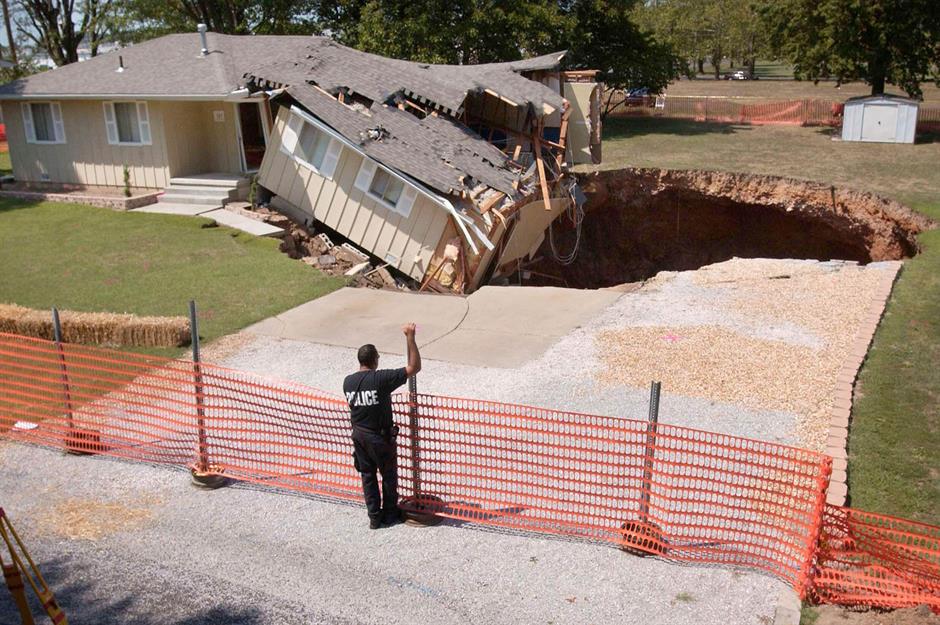
Whether ravaged by natural disasters or destroyed by mankind, these unfortunate homes all disappeared from sight. From overnight sinkholes and avalanches to wildfires and crumbling cliffs, these outlandish but true tales are stranger than fiction.
Budding detectives should pay close attention to the mystery of the ‘vanishing house’ on Tory Island and see if they can work out what really happened before we reveal all.
Click or scroll on to discover these extraordinary vanishing properties...
Wildfires
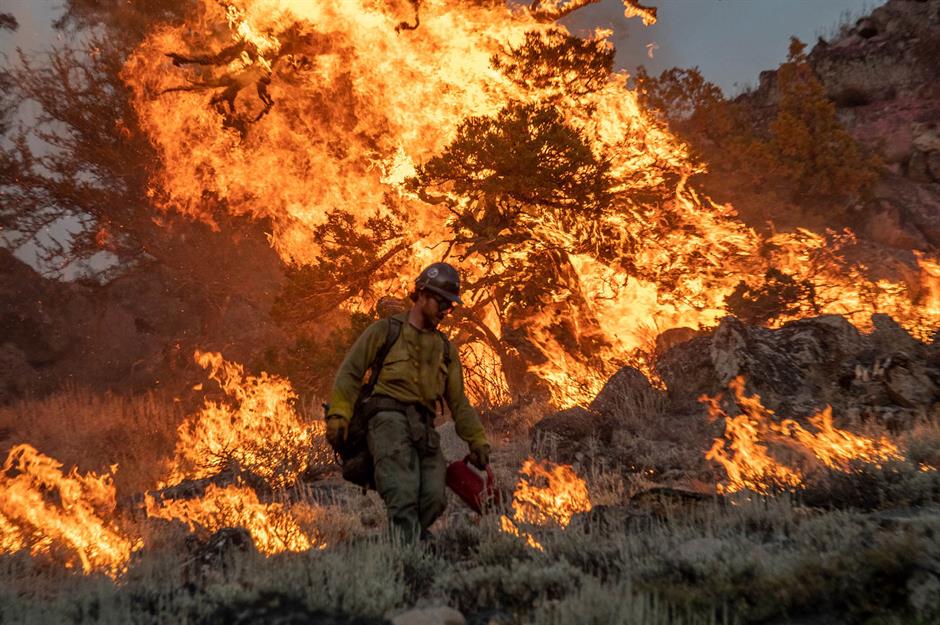
Thanks to rising temperatures around the world, wildfires are becoming more common than ever. Uncontrolled and unpredictable, they ravage everything in their path and can destroy whole villages and towns in a matter of hours.
From Hawaii and South Africa's Western Cape to Greece, Spain and even Siberia, recent fires have burned on a staggering scale, causing chaos, destruction and death.
Wildfires: California, USA
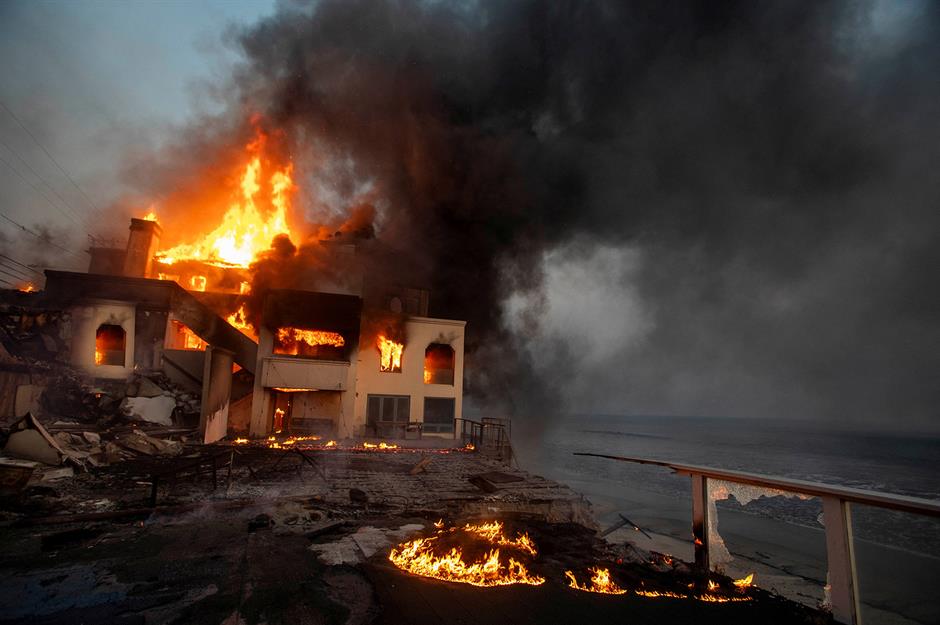
In January 2025, 29 wildfires hit California, burning thousands of acres of land and forcing more than 100,000 people from their homes. The deadliest and most destructive of these was the Palisades Fire, which burned 23,707 acres (9,594ha), destroyed more than 6,800 buildings and killed 11 people, making it the 10th deadliest fire in California history.
Celebrities including Mel Gibson, Paris Hilton, Bella Hadid and Sir Anthony Hopkins lost their homes when the fire tore through the largely wealthy Pacific Palisades, Malibu and Topanga neighbourhoods of Los Angeles.
Wildfires: California, USA

At its peak, the fire spread at a rate of "five football fields per minute", according to British newspaper The Independent. The devastation it left in its wake is clear to see from this photo of the Malibu coast, which was once lined with iconic beachfront homes and famous restaurants.
California's deadliest wildfire was the notorious Camp Fire, which hit Butte County in Northern California in November 2018. It burned 153,336 acres (62,053ha), destroyed more than 18,800 structures and killed 85 people.
Wildfires: Lytton, Canada
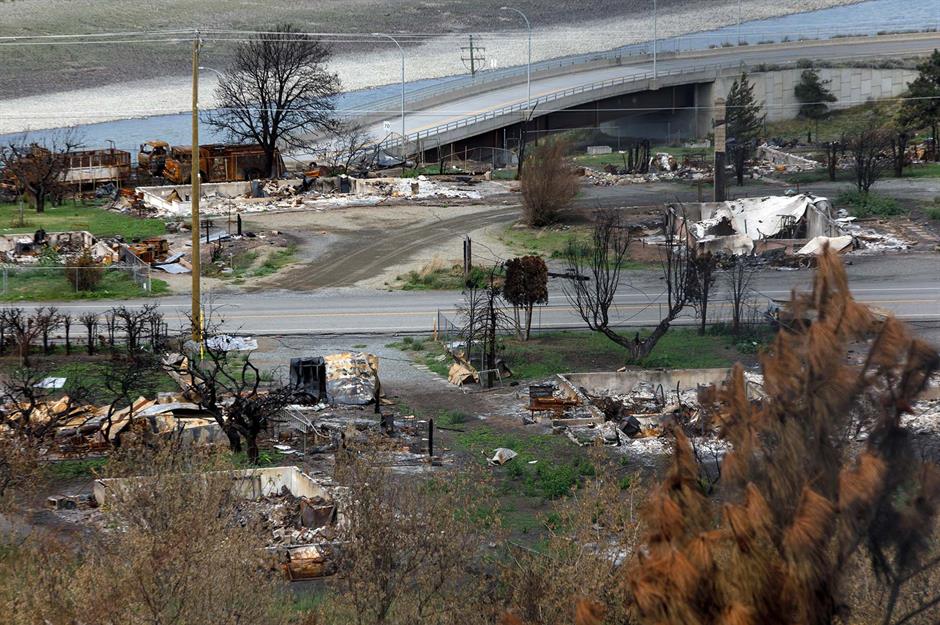
On 29 June 2021, the temperature in the small village of Lytton, Canada officially hit 49.6ºC (121.3ºF). That's the highest temperature ever recorded in Canada, Europe and South America, and the hottest in the US outside of the southwestern states.
The very next day, a devastating wildfire tore through the community, burning 90% of the village and killing two residents.
Wildfires: Lytton, Canada
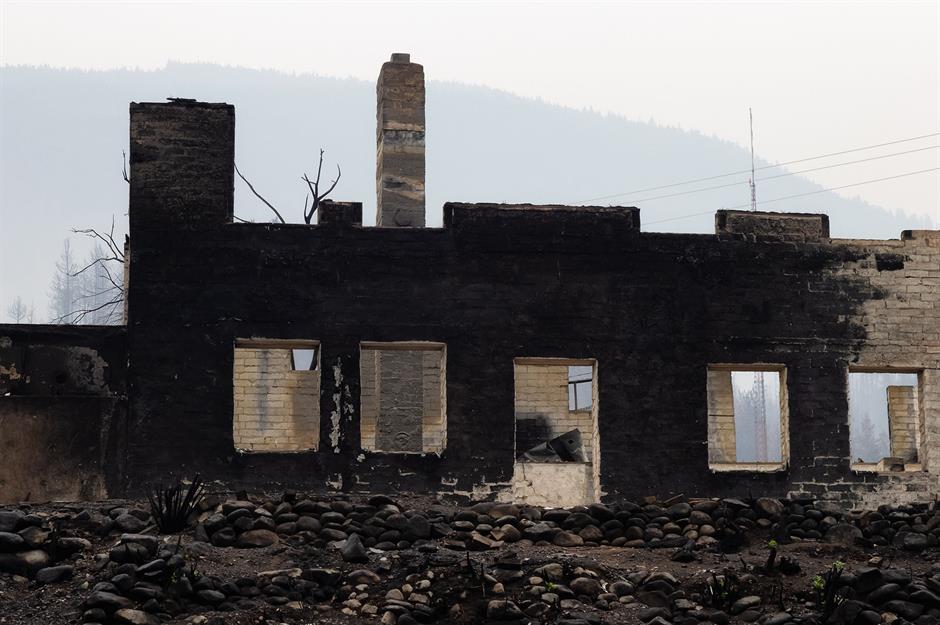
Located 162 miles (260km) northeast of Vancouver, Lytton was engulfed by a "wall of fire", according to the town's mayor, who was lucky to escape the inferno with his life.
"Within about 15 minutes the whole town was engulfed in flame," Mayor Polderman told the BBC. "People basically just grabbed their pets, grabbed their keys and got into their car and fled."
Just a year later, a second wildfire destroyed six homes just across the river.
Sinkholes
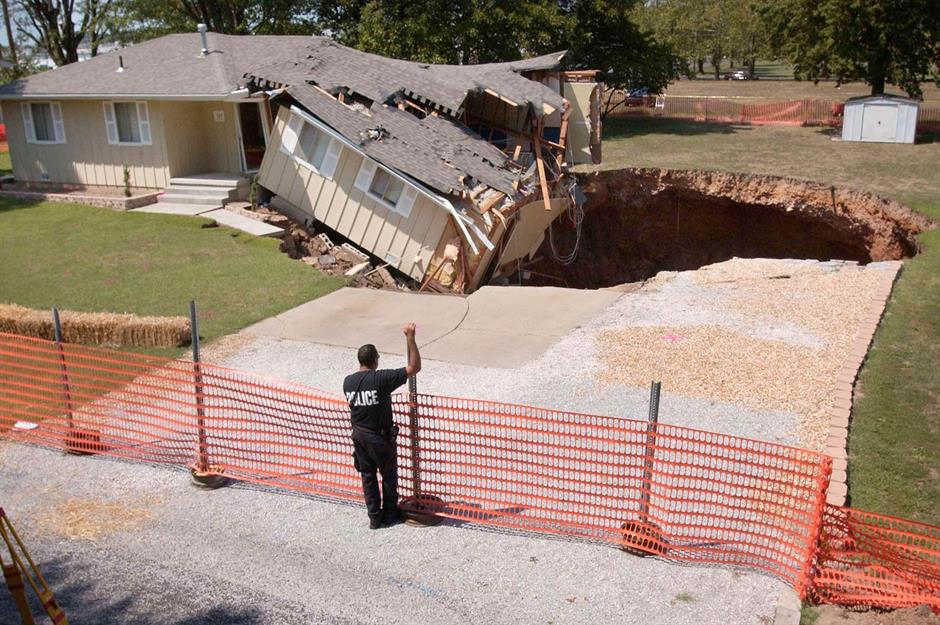
Often appearing in moments and swallowing homes, cars and even people, sinkholes are formed when acidic water eats away at chalk or limestone rock beneath the ground. Heavy rainfall, poor drainage, burst water mains and construction can also cause these cavernous craters to appear.
The entire state of Florida is built on limestone, making it particularly susceptible to sinkholes...
Sinkholes: Florida, USA
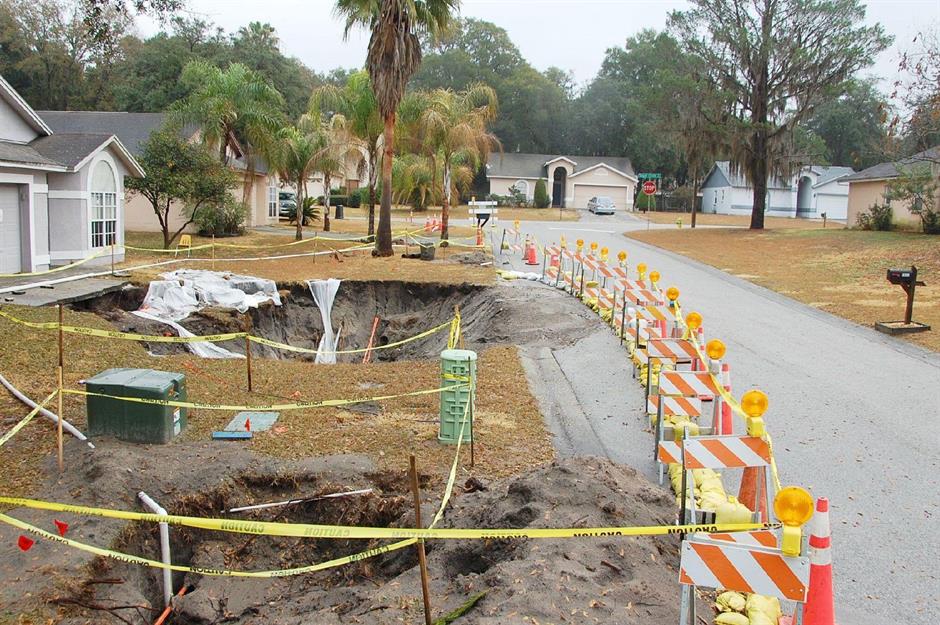
One particularly worrisome way your house might disappear is if it is swallowed up by the ground. Sinkholes are a very real worry for citizens of Florida, the state most at risk of sinkholes in the entire US.
Over 110 sinkholes appeared in the Dover area of Florida during a freeze event in 2010, causing the destruction of roads, homes and cultivated areas. According to the US Geological Survey, the sinkholes occurred due to farmers quickly pumping groundwater in anticipation of the freeze.
Sinkholes: Florida, USA
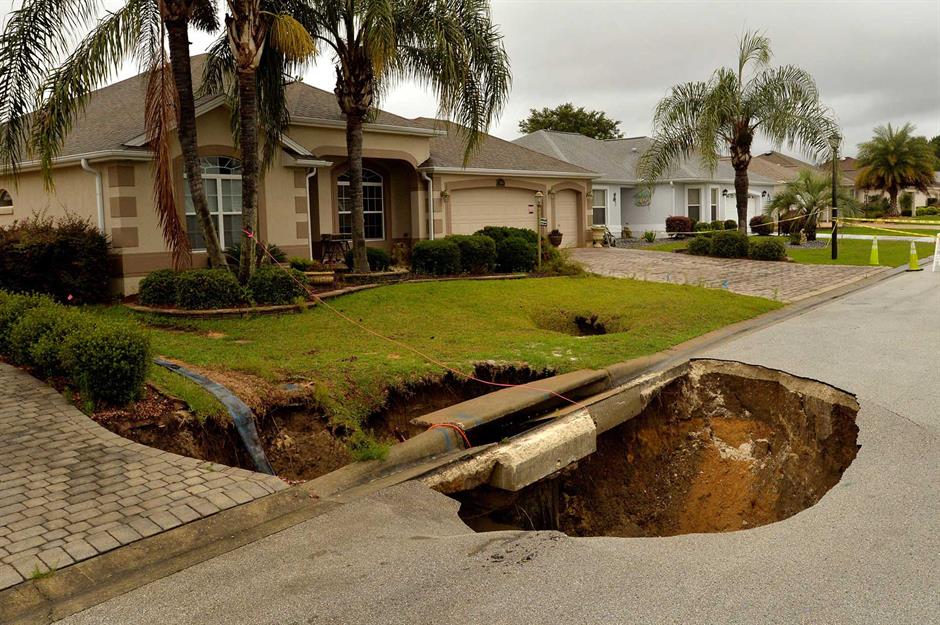
Florida is particularly affected by sinkholes due to the limestone beneath the ground, which is slowly dissolved by natural acids in the rain and soil, according to the Florida Department of Environmental Protection.
They are also a consequence of man-made development, as the weight of buildings and the impression left by vehicles damage the protective layers of soil and aggravate weak points. Marion County, pictured here in a news report, is listed at number 4 on RiskMeter’s list of the most sinkhole-prone counties in Florida.
Sinkholes: Florida, USA
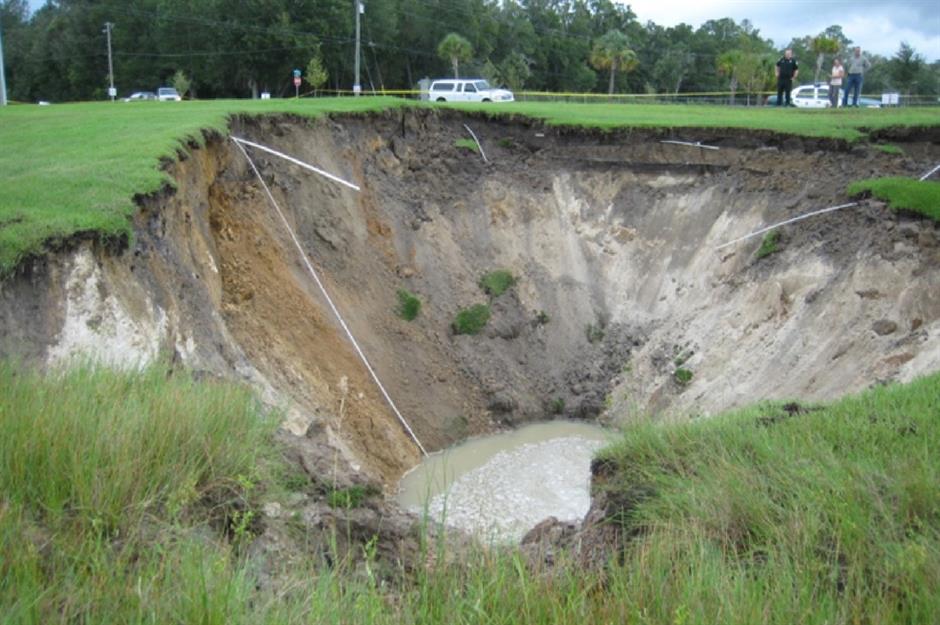
This sinkhole – a whopping 35 feet (11m) by 50 feet (15m) in circumference and approximately 10 feet (3m) deep – occurred following heavy rain in the city of Alachua, opening in a stormwater retention area near the residential area.
Florida Geological Survey geologist Clint Kromhout told the Orlando Sentinel that there have been just four sinkhole deaths reported in the state, and that sinkhole fatalities are “extremely rare”.
Sinkholes: Florida, USA
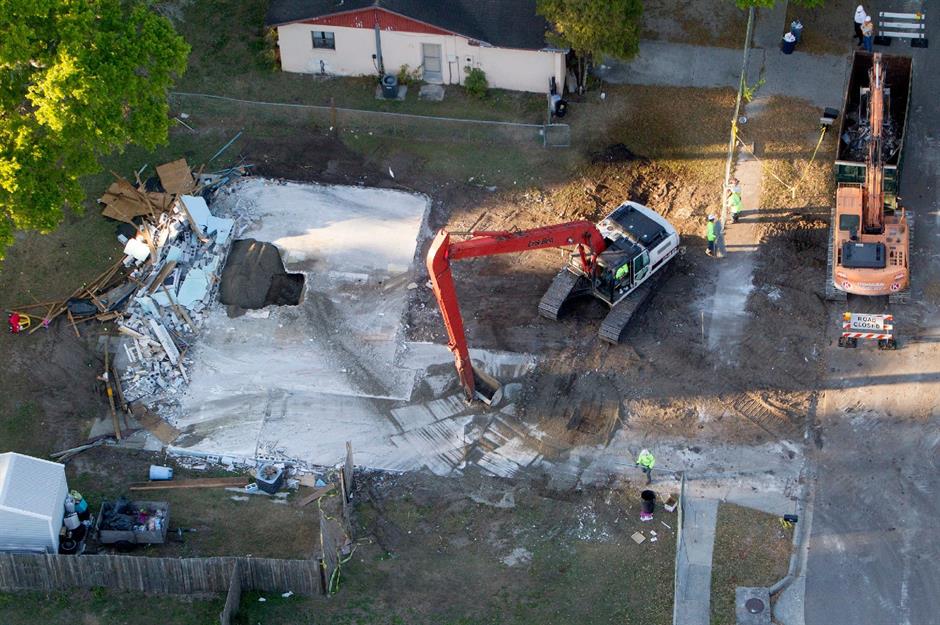
Jeffrey Bush was asleep in bed when a giant sinkhole opened up and engulfed his bedroom on February 28, 2013. Despite the desperate attempts of his brother and emergency responders to save him, Bush did not survive the sinkhole, which measured 15 feet (5m) wide and 20 feet (6m) deep. Indeed, a second collapse swallowed rescue crews’ listening devices as they tried to locate the Floridian.
Deemed too dangerous for habitation, the house was later demolished. The notorious sinkhole returned two years later, although thankfully no one was hurt.
Sinkholes: Surrey, UK
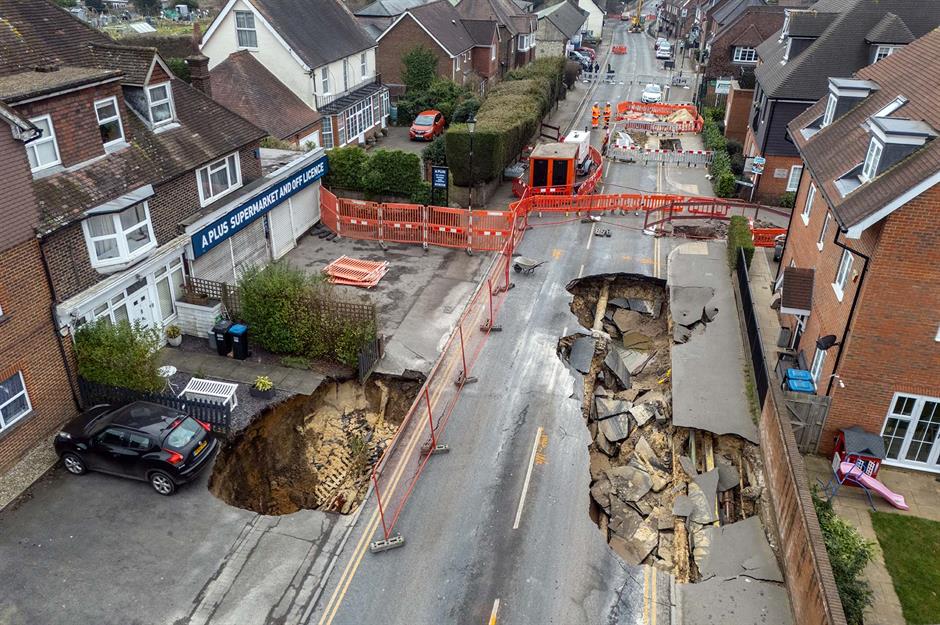
On the night of 17 February 2025, a sinkhole opened up on Godstone High Street in Surrey, England. In a matter of hours, it had grown to 65 feet (20m), swallowing one resident's garden and threatening surrounding homes.
Shortly after midnight, police ordered locals to "get out as quickly as possible" due to fears that exposed cables and a burst water main could cause an explosion.
Sinkholes: Surrey, UK
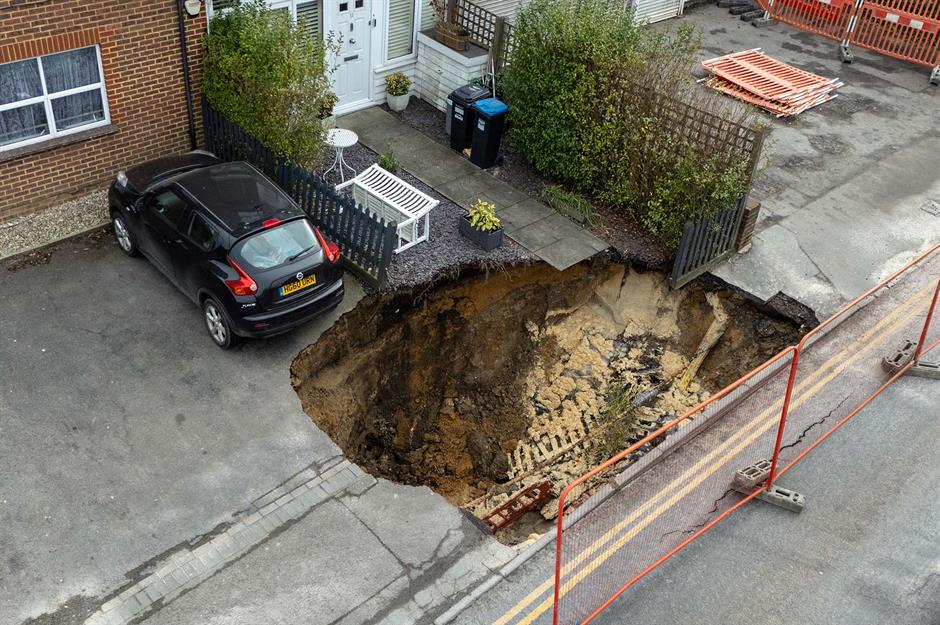
The following day, a second hole appeared opposite the first, sparing this car by inches. A total of 30 houses were evacuated, forcing some residents to sleep in their vehicles. Over a week later, 24 homes remained uninhabitable and some residents were told it could be months before they could return.
Godstone was built above a maze of disused caves and sand quarries and it's possible they contributed to the frightening phenomenon.
Coastal erosion
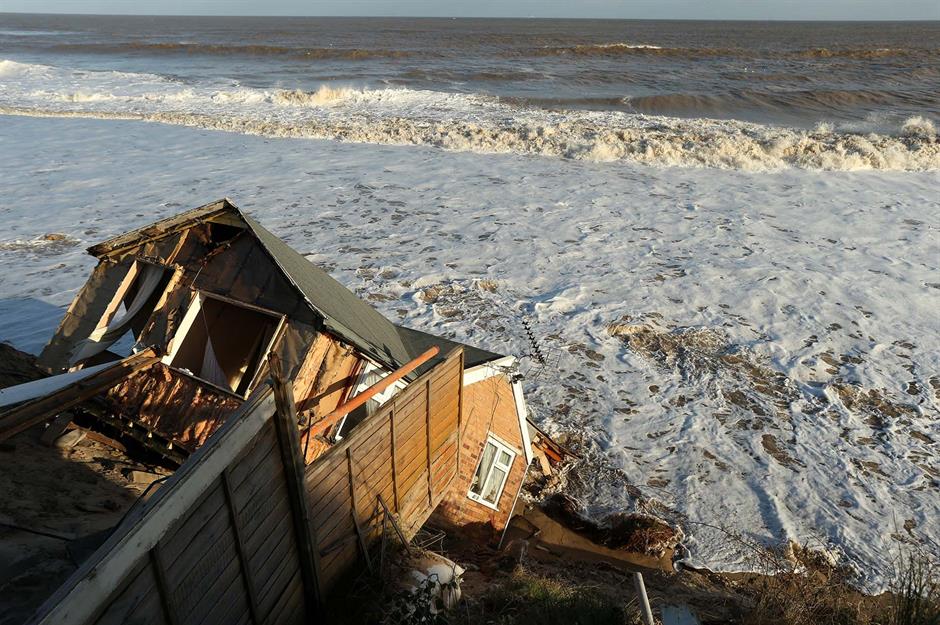
Powerful waves crashing against the shore is an awesome sight, but not if your house is teetering precariously on a clifftop above. Over time, waves wash away sandy soil and force their way into cracks in the cliff face, gradually turning them into caves and arches, literally undermining the land above.
Sadly, rising sea levels and an increase in extreme weather events has led to a swell in towns being slowly swallowed by the sea...
Coastal erosion: Wamberal, Australia
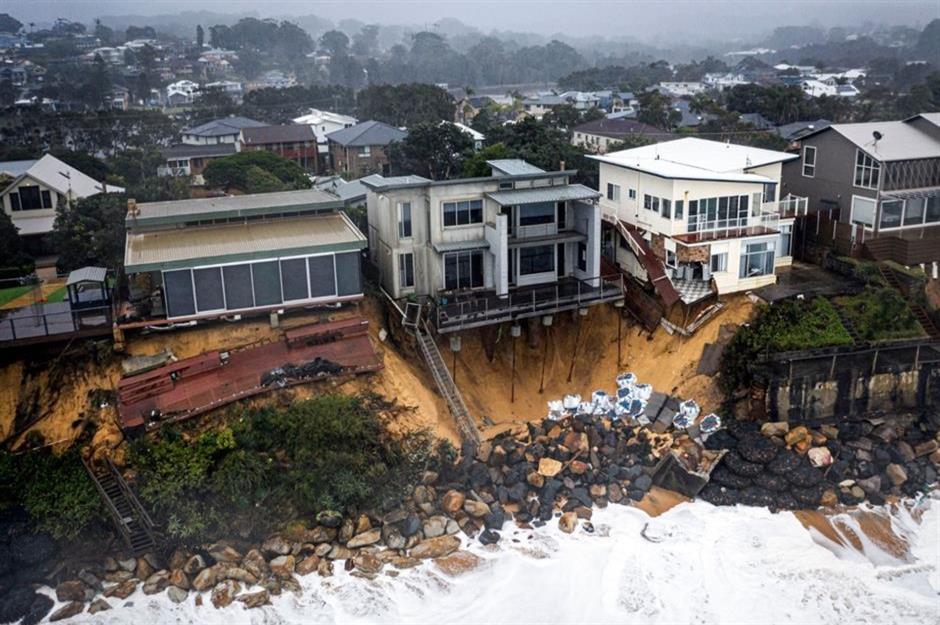
While a beachfront home in sunny Australia might sound appealing to most, these coastal houses in New South Wales would turn that particular dream into a nightmare. Residential homes along the shoreline enjoy more than their fair share of ocean views, but are slowly being swallowed up by the sea.
The unreliable climate and rising sea levels of the Wamberal coastline mean these houses have been falling victim to coastal erosion since the 1970s.
Coastal erosion: Wamberal, Australia
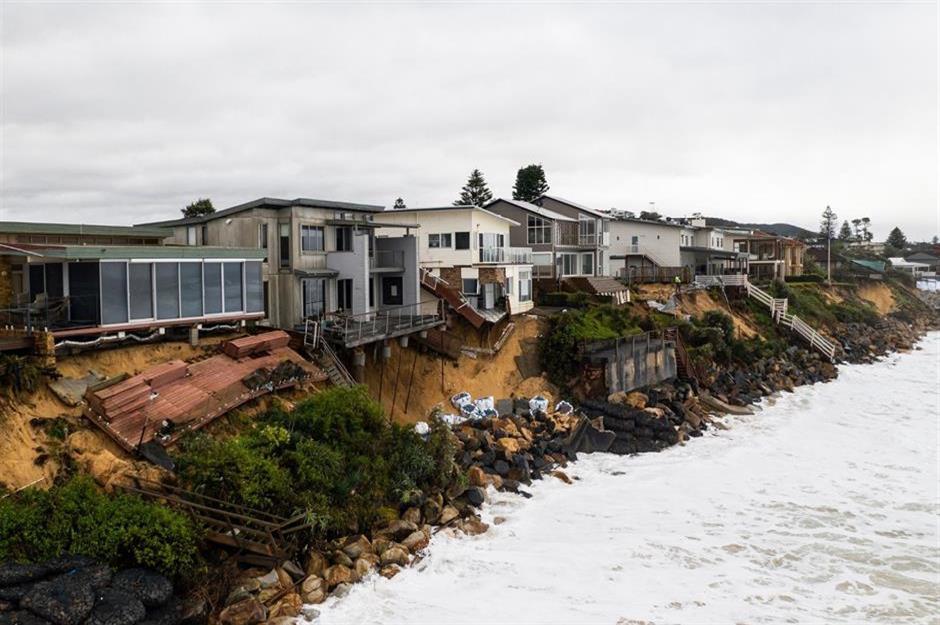
The beachfront was hit with severe storms in July 2020, causing some homes to partially collapse into the sea.
Work began in 2023 to build a seawall to protect the beach. While owners of shorefront homes welcomed the move, other local residents believe it will cause damage to the beach and impact tourism to the area.
Coastal erosion: Norfolk, UK
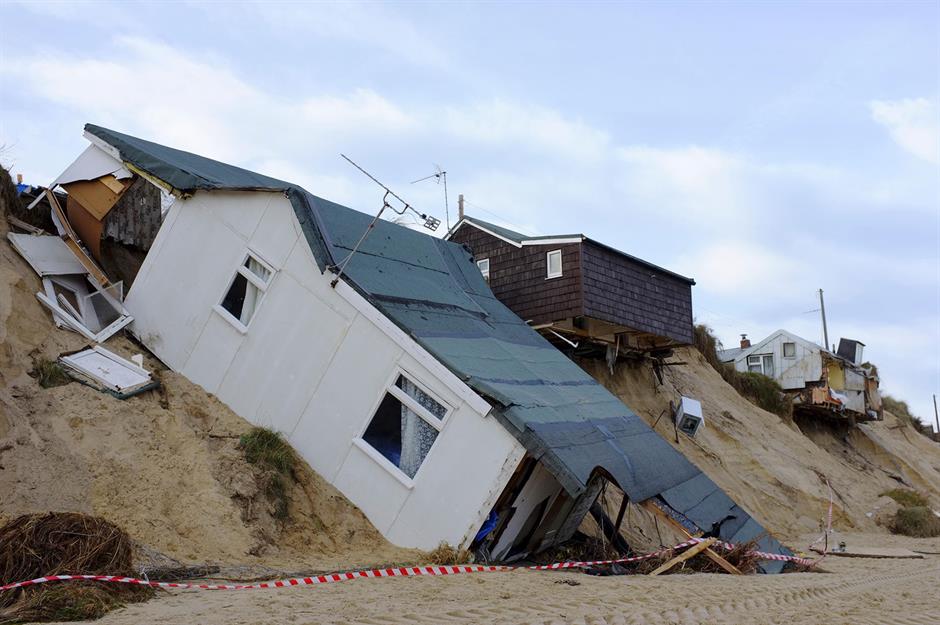
More idyllic coastline beckons, in the form of the village of Hemsby on Britain's Norfolk coast. However, these alluring sandy vistas are just as dangerous as the house-swallowing seas of Australia. Norfolk's appealingly soft sand and clay coastline has been naturally eroding for centuries, but climate change and the resulting rising sea levels have exacerbated the problem.
Here, the seafront houses fall prey to an ever-eroding coastline, not helped by a particularly destructive storm in 2013, which completely destroyed seven properties, and left many more damaged.
Coastal erosion: Norfolk, UK
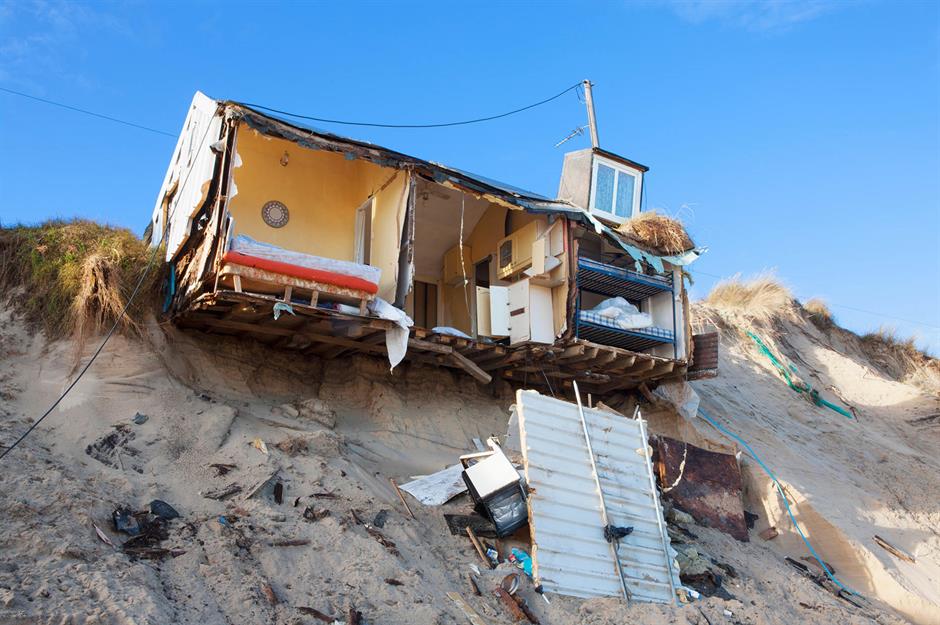
According to the BBC, it has been estimated that Hemsby has lost 984 feet (300m) of its coastline since the 1970s, thanks to extreme winters, storms and rising tides.
In 2018, disaster struck again when the 'Beast from the East’ storm destroyed 13 homes along the seafront. In 2023, ferocious storms led to a further eight homes being torn down.
Landslides
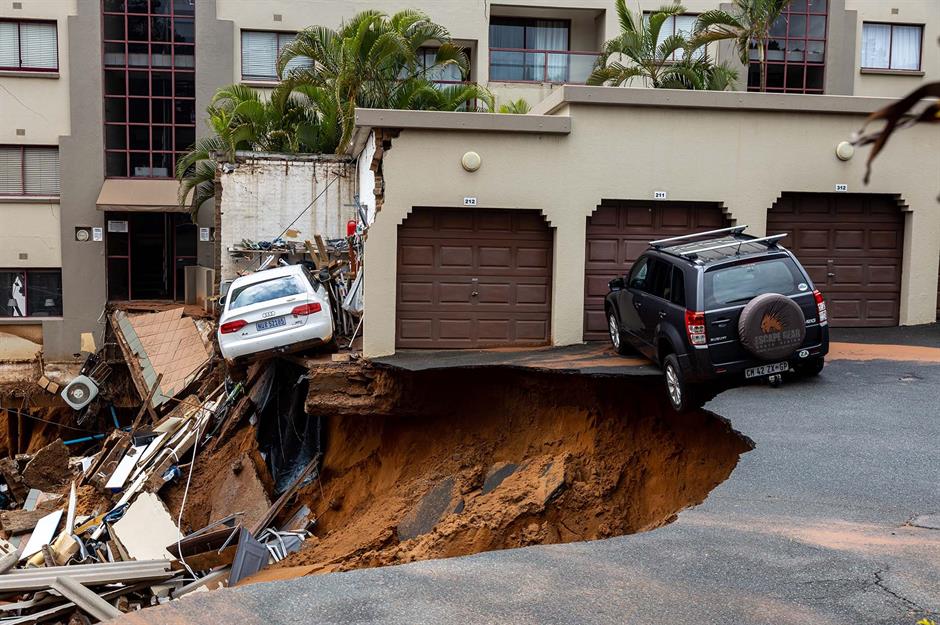
Rain, flooding, earthquakes and even volcanos can cause earth and rock to slip down hillsides, mountains and ravines.
While we might think of them happening most frequently in rural areas, they can and do take place in towns and villages – often with disastrous consequences. Each year, landslides cause between 25 and 50 deaths and $3.5 billion (£2.8bn) damage in the US alone.
Landslides: Erftstadt-Blessem, Germany
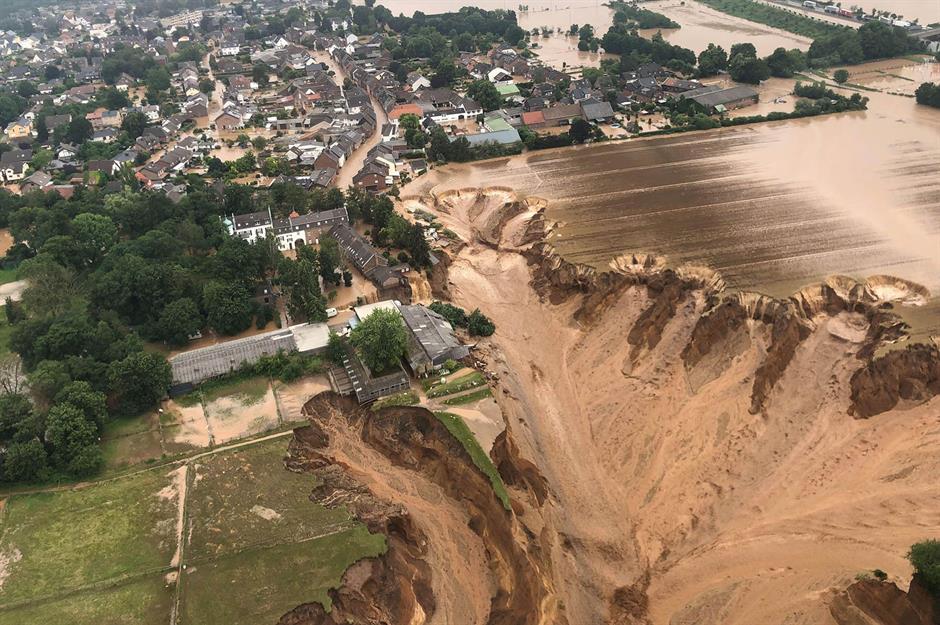
In July 2021, more than 200 people in western Germany and eastern Belgium were killed when the area was hit with catastrophic floods.
In the German town of Erftstadt-Blessem, located 17 miles (27 km) southwest of Cologne, flash flooding caused a major landslide that swept away properties, cars and even people.
Landslides: Erftstadt-Blessem, Germany
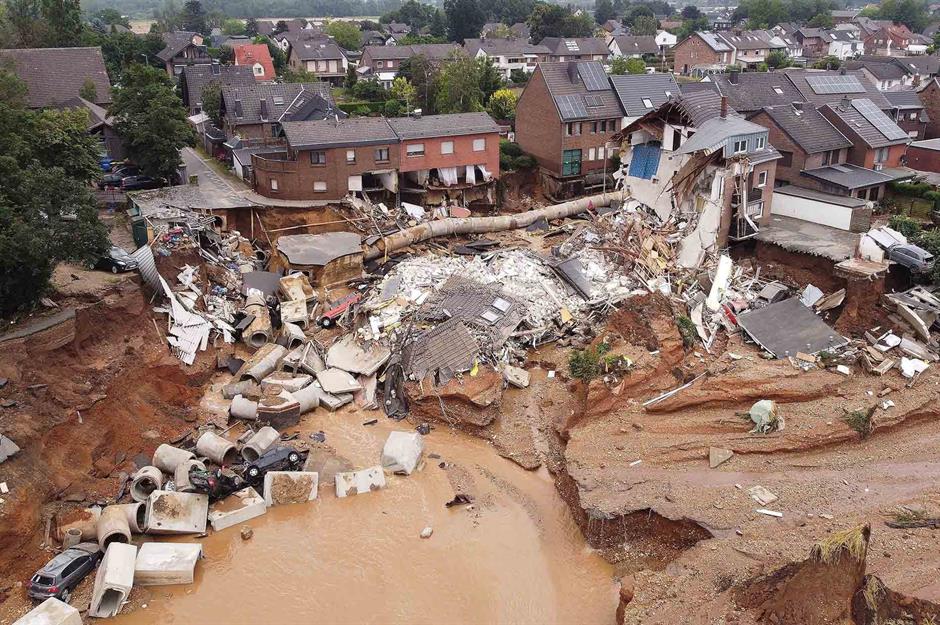
Multiple people were trapped inside their homes and least 55 people had to be rescued after houses collapsed throughout the town. While several people were initially feared dead, no one was killed. Troops were deployed across the area to help in the wake of the disaster, which caused "dramatic and enormous" damage, according to the state premier.
The landslide left an enormous crater in its wake, but that wasn't the only reminder that plagued the townspeople. Shockingly, Erftstadt-Blessem was inundated with visits from 'disaster tourists' for months after the catastrophe.
Landslides: Utah, USA
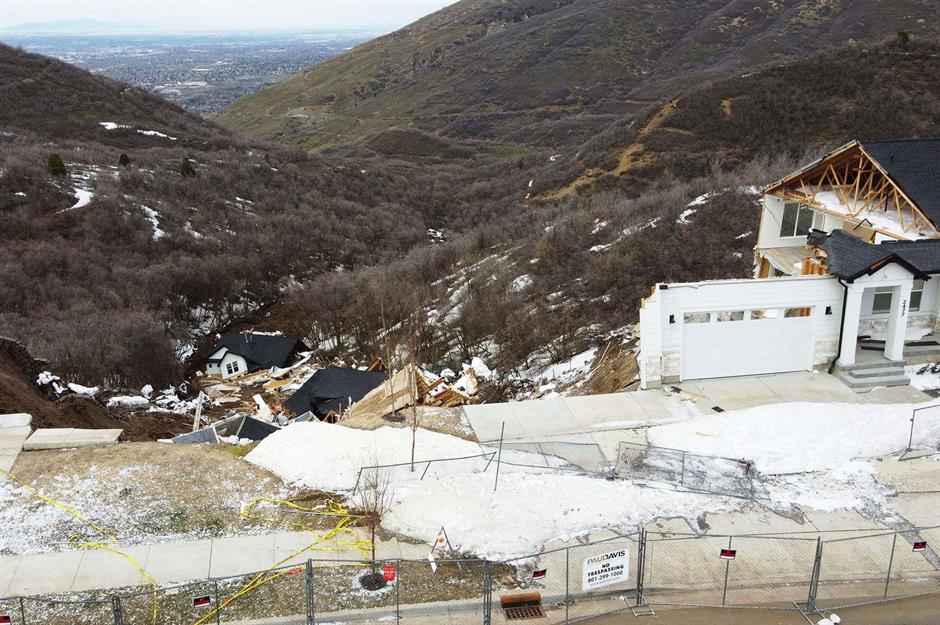
We all dream of moving into the perfect home, but what happens when a dream home becomes a nightmare? Families in Draper, Utah experienced just that in April 2023, when their houses slid off their foundations and crashed hundreds of feet down a canyon.
The homes – which were worth a combined $2 million (£1.6m) – were thankfully empty at the time. Draper City officials had revoked the Certificates of Occupancy in October 2022, forcing the evacuation of the two homes.
Landslides: Utah, USA
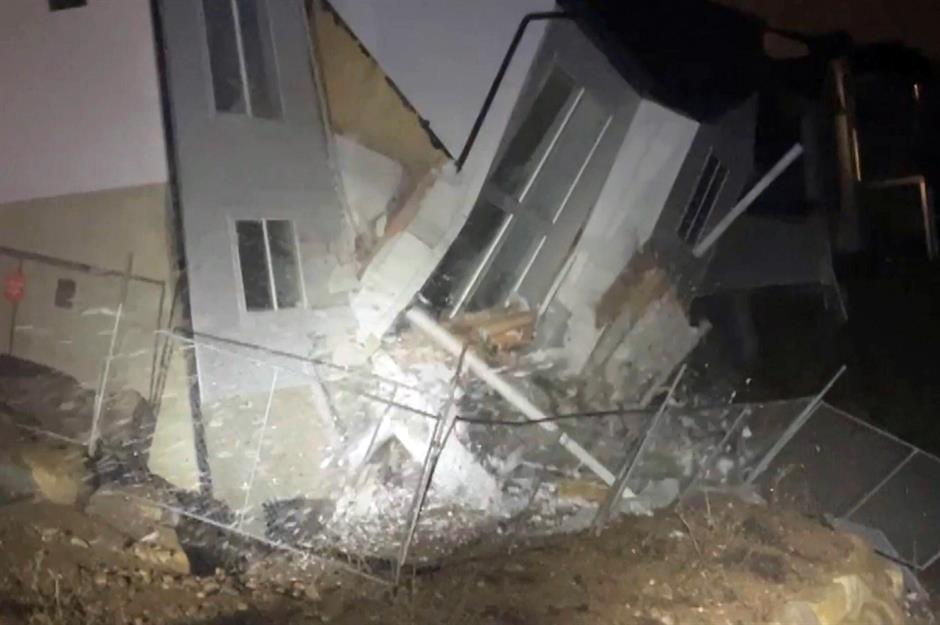
This photo captures the moment one of the houses collapsed. The properties, located on East Springtime Road in the Hidden Canyon Estates, collapsed due to sliding. Engineers, building officials, and public safety personnel on site determined that two more homes were at risk and residents were evacuated.
Possible reasons for the landslide included the melting snowpack, fill material that wasn't compacted correctly or a combination of factors.
Landslides: Schwanden, Switzerland
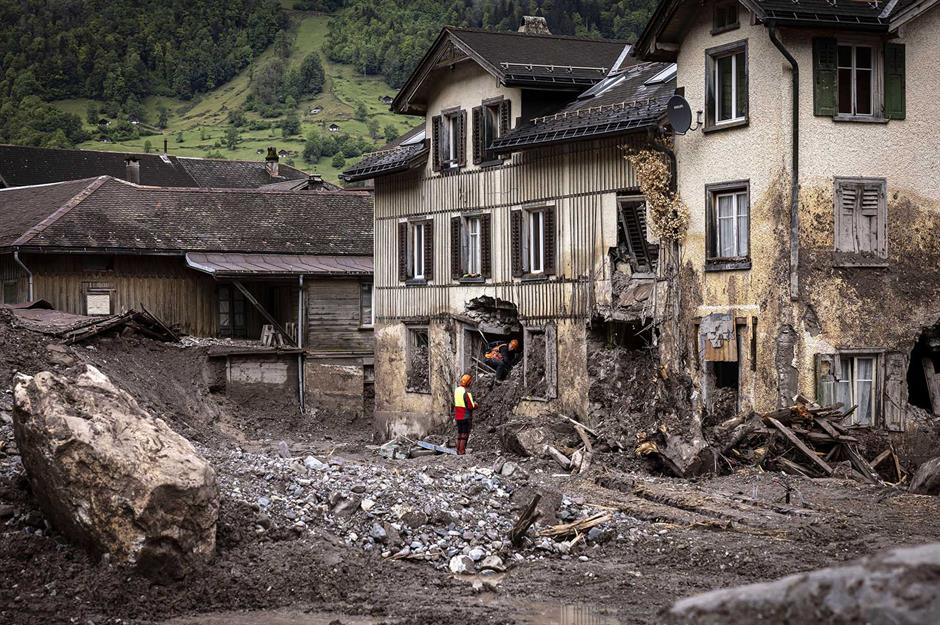
On 29 August 2023, a landslide of earth and rock crashed into the village of Schwanden. More than 1 million cubic feet (30,000 cubic metres) of debris hurtled around 1,300 feet (400m) downhill before hitting the buildings and a second landslide followed just a few hours later. Thankfully, no one was injured but more than 100 residents were evacuated.
The following December, the area was hit with another 530,000 cubic feet (15,000 cubic metres) of debris. All in all, the slides destroyed or partly buried 33 properties.
Landslides: Schwanden, Switzerland
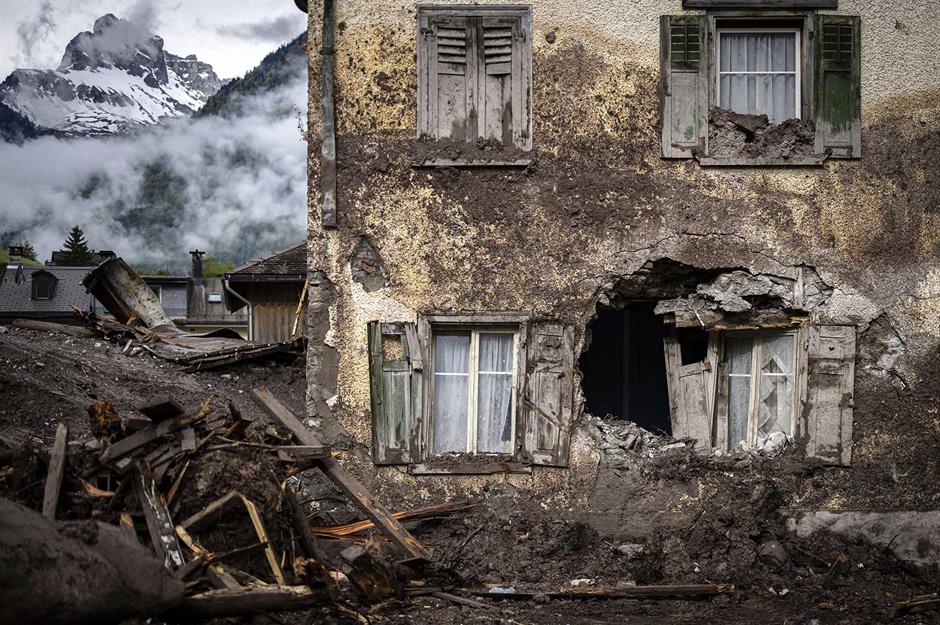
A year later, most of the affected buildings had been demolished. However, while a 21-foot (6.5m) high dam was built to protect the remaining structures, 46 people permanently lost their homes and 25 lost their workplace.
The local government has set aside CHF7.4 million ($8.2m/£6.5m) to pay for the dam, which now holds back more than 2 million cubic feet (60,000 cubic metres) of highly unstable material still at risk of slipping, as well as a monitoring system. Some of the money went towards reimbursing the local municipality, which had to buy the destroyed homes to build the dam.
Sandstorms
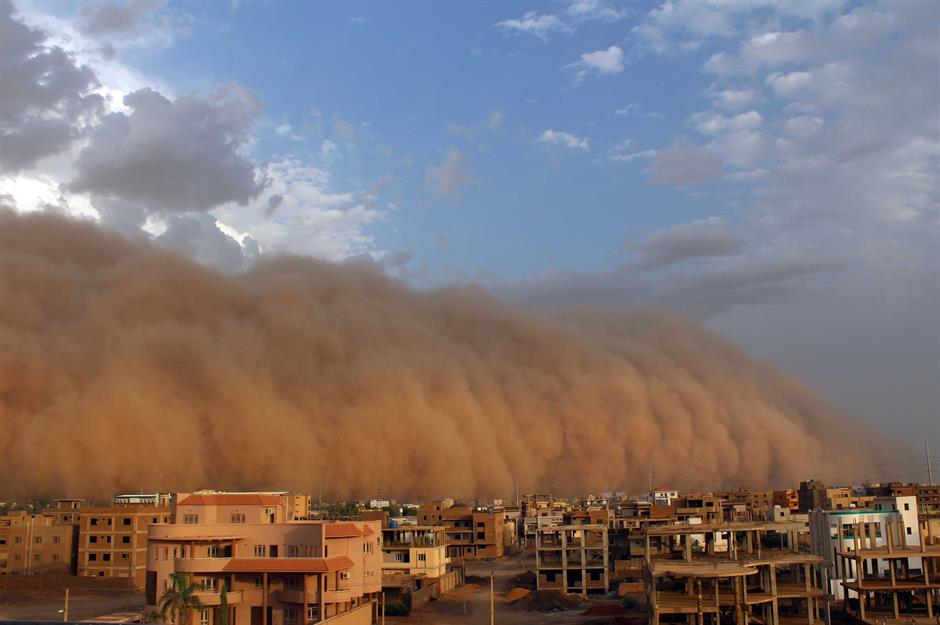
Dust and sandstorms – like this one pictured rolling over Khartoum, Sudan – are the result of winds speeding through dry areas that don't have much plant life to anchor the earth and slow down the gusts.
Particles of sand, dust and earth are lifted into the air and combine to form massive clouds – particularly in China's Gobi Desert, the Sahara in North Africa and southwest America, where it's so bad that it earned the nickname 'the dustbowl' back in the 1930s.
Sandstorms: Al Madam, UAE
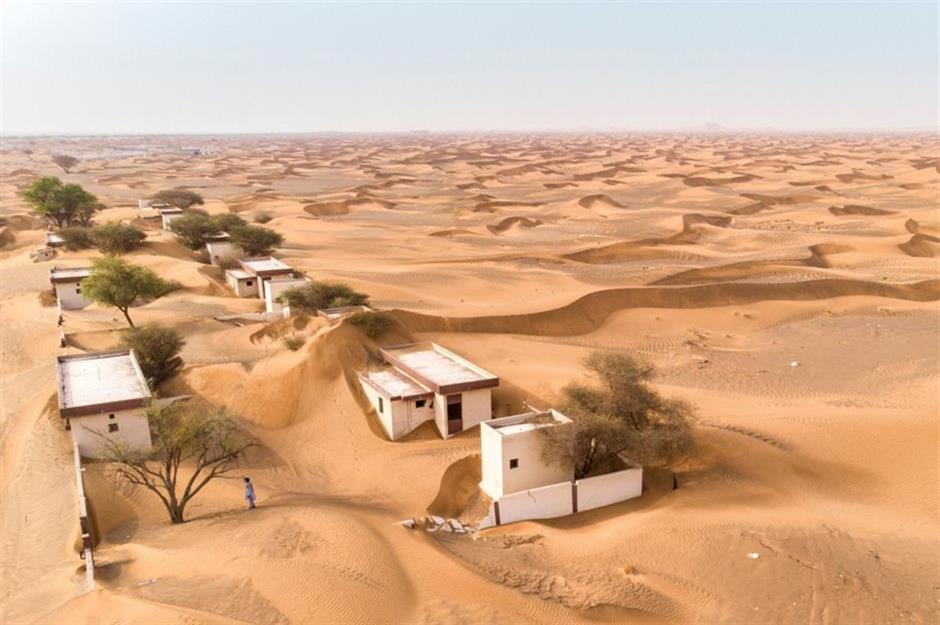
While the sea poses an immediate threat to some houses, sand can be just as problematic for others. The village of Al Madam in Sharjah, United Arab Emirates, has been engulfed by desert sand, leaving nothing more than rooftops in sight.
Vanishing into the dunes, the ghost town has been left uninhabited for over 30 years.
Sandstorms: Al Madam, UAE
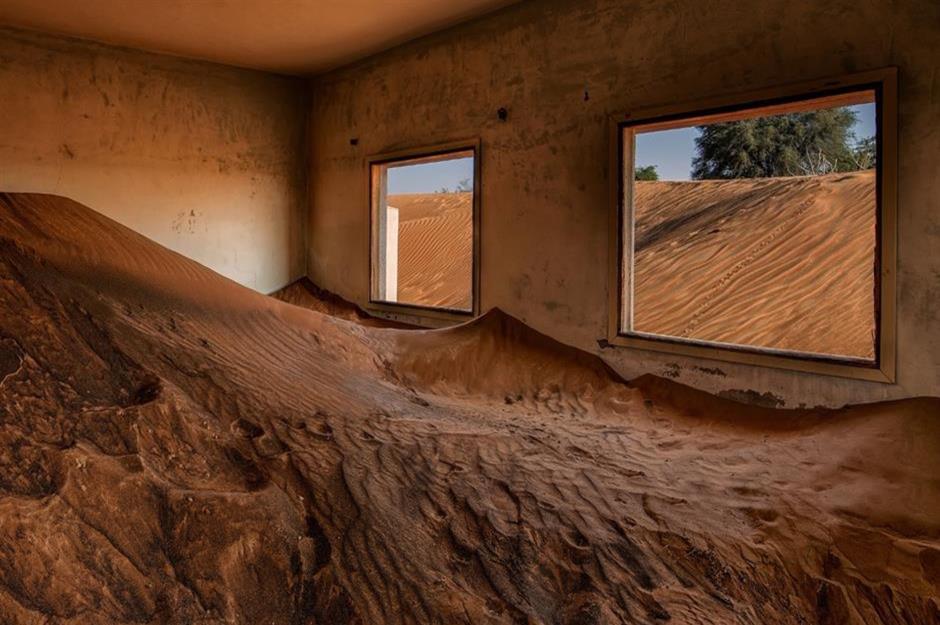
Sand can be seen flowing through windows and doors, swallowing up corridors and entire buildings. Many of the homes are believed to have been hastily deserted, with belongings left in their rooms.
Al Madam has become somewhat of a tourist attraction, however, as visitors travel to the spooky abandoned village to photograph what remains.
Sandstorms: Kolmanskop, Namibia
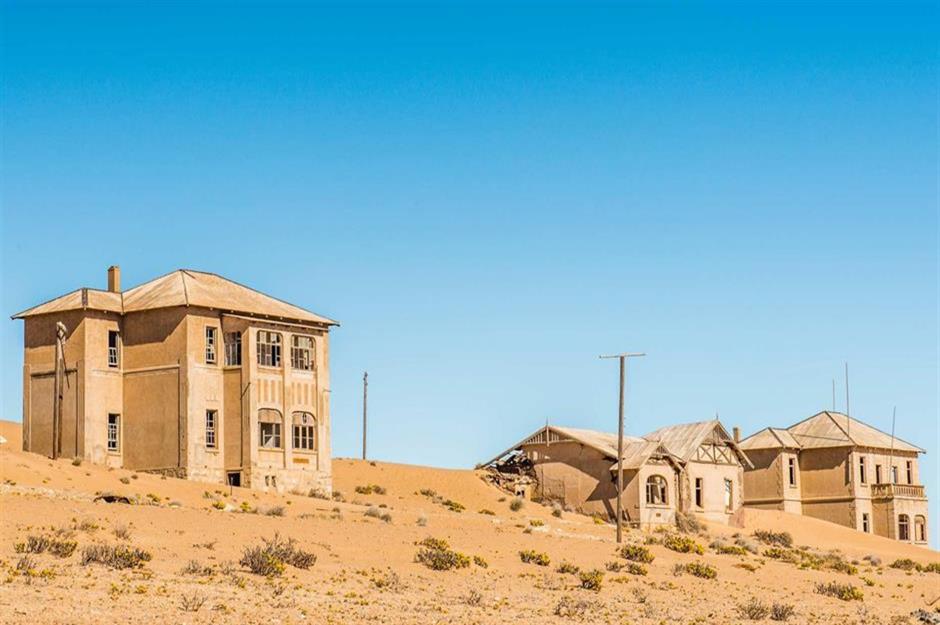
Another disappearing community lost to sand is the mining settlement of Kolmanskop, in the Namib Desert of Southern Africa. Producing 11.7% of the world’s diamonds, this town was one of the richest in the world in the early 1900s.
However, intensive mining had depleted the area by the 1930s. In 1928, the richest diamond fields were found on the beach terraces to the south, pushing residents to leave the town in their hordes.
Sandstorms: Kolmanskop, Namibia
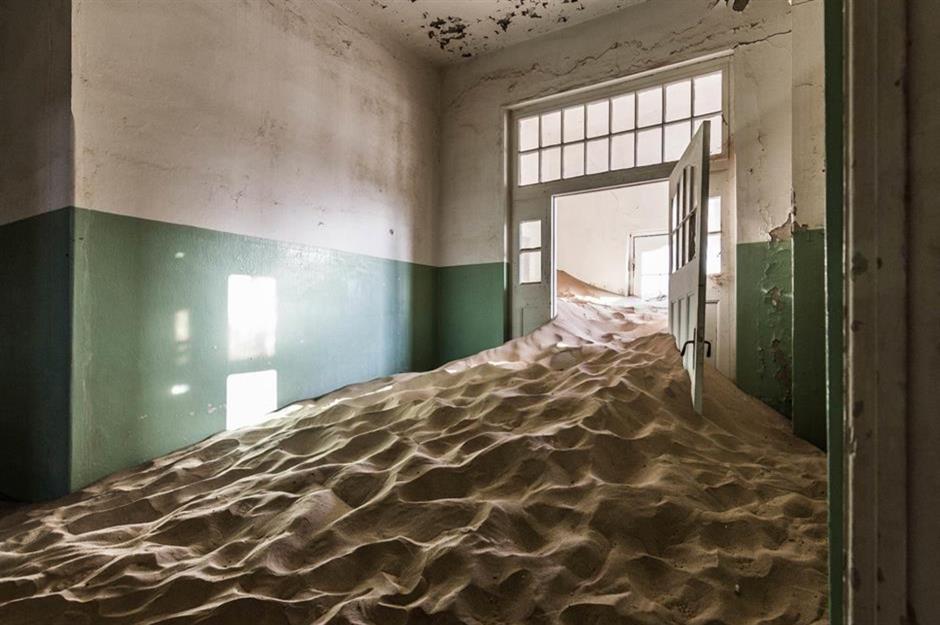
Deserting their homes and belongings, the townspeople abandoned Kolmanskop in droves. By 1956, the once-affluent community with its own railway station and outdoor swimming pool had lost the fight with Mother Nature.
Sand dunes have blown through doors and windows, engulfing every building within the village, such as this hospital pictured. In 2002, a private company won funding to transform the abandoned village into a tourist attraction and several of the historic buildings have since been restored.
Avalanches

At their best, avalanches are breathtaking examples of nature's power and beauty – at their worst they're deadly, destroying everything in their path.
Heavy snowfall, high winds, rising air temperature, terrain and snowpack conditions all contribute to avalanche risk. Once conditions are just right, all it takes is a trigger to unleash the snow's explosive power. Natural triggers include fresh snowfall and the collapse of an icy overhang, while human triggers include winter sports, snowmobiles and explosions.
Slab avalanches are the most destructive and can reach speeds of 80 miles (130km) per hour, obliterating anything in their path – including homes.
Avalanches: Andermatt, Switzerland
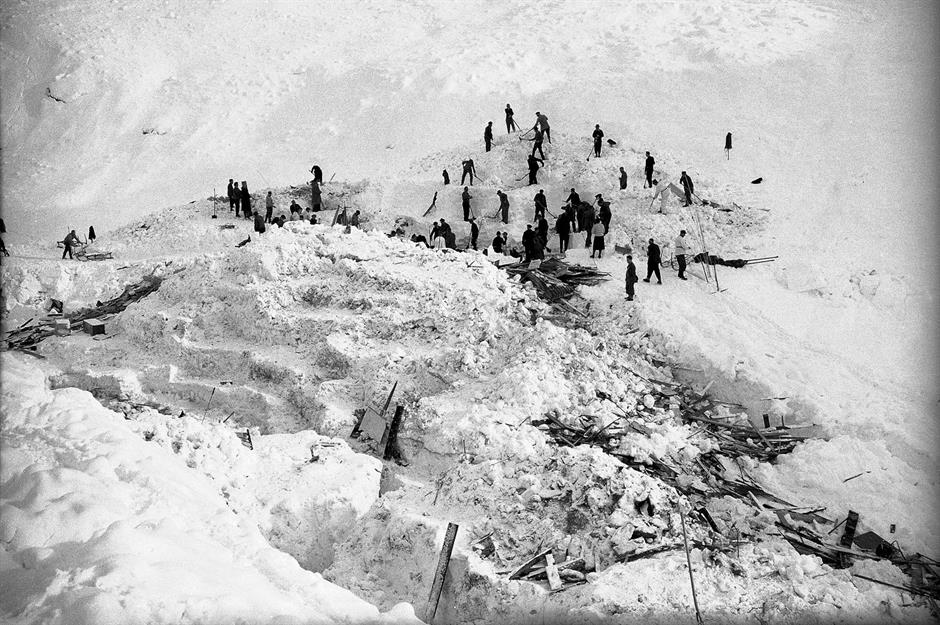
In the winter of 1950 and 1951, the Swiss, Austrian and Italian Alps were hit with thousands of avalanches caused by hurricane-strength winds and heavy snowfall. The conditions proved so deadly that the period has become known as 'the winter of terror'.
The Swiss village of Andermatt was hit by several avalanches in a short space of time on the same day, killing 13 and destroying homes, farm buildings and a hotel. This photo shows search parties desperately looking for survivors of 'the white death' among the snow and debris.
Avalanches: Andermatt, Switzerland
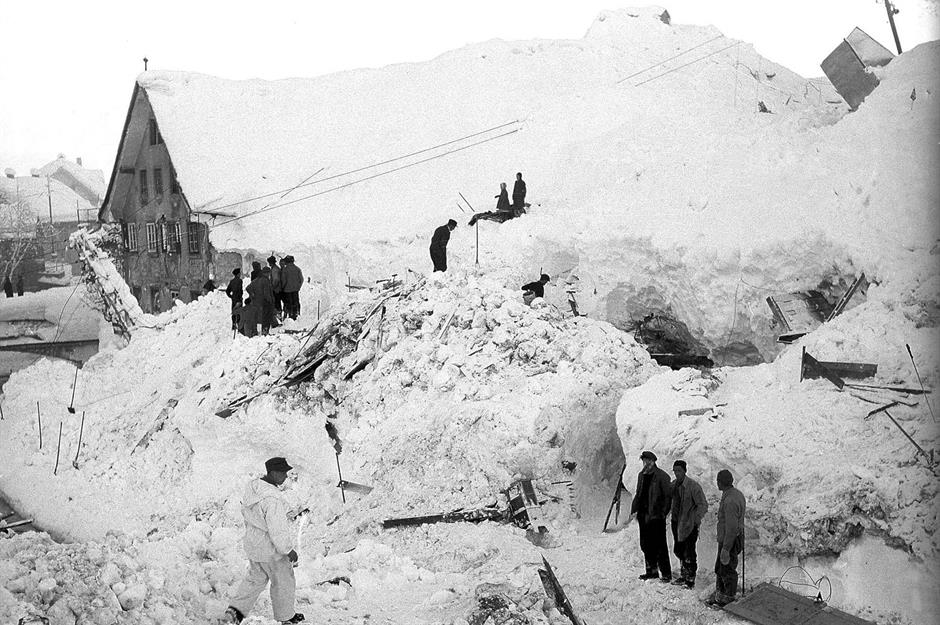
More than 265 people across the Alps were killed and 45,000 trapped by the avalanches that winter. The event holds the unwanted world record for the most people trapped by an avalanche disaster.
The tragedy prompted the Alpine countries to overhaul their avalanche prevention and response methods. These included mountain-top weather stations, avalanche barriers, strategically-planted forests, avalanche-hazard mapping and mountain rescue dog training.
In 1999, the area was hit with a similar number of avalanches, but, while 17 people sadly died, there were many fewer fatalities thanks to lessons learned from the Winter of Terror.
Avalanches: Montroc, France
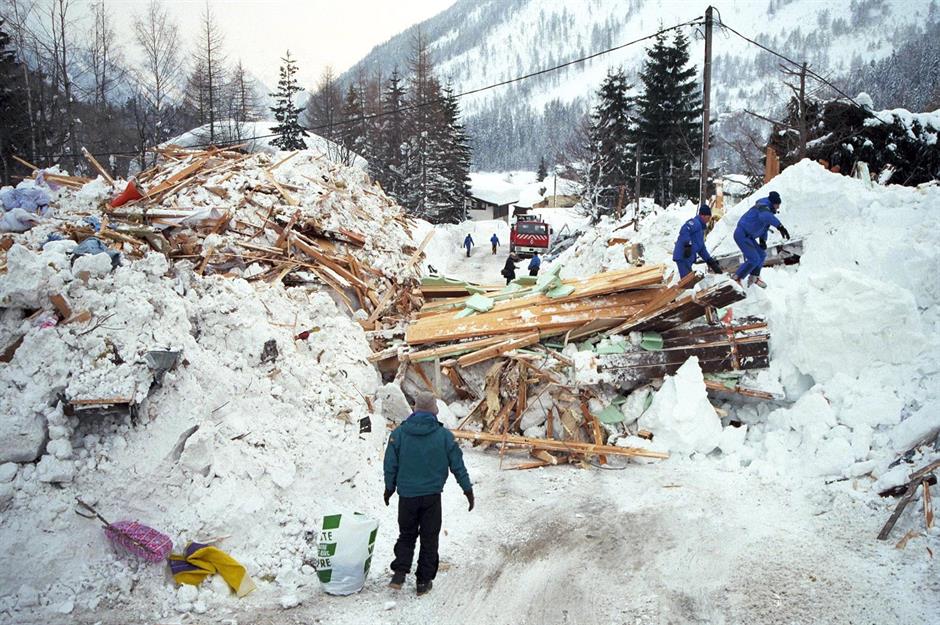
On 9 February 1999, a 74-acre (30ha) snow slab broke away from the mountainside above Montroc in the Chamonix Valley. It reached a speed of 60mph (97kmph) before slamming into the hamlet, killing 12 people, destroying 14 chalets and badly damaging six.
As we can see from this image taken the following day, the chalets were decimated. Many were buried under snow to a depth of 16 feet (5m). Thankfully, 15 chalets were empty at the time – the death toll could have been much higher if the avalanche had hit two days later, when Parisian holidaymakers were due to arrive.
Avalanches: Montroc, France
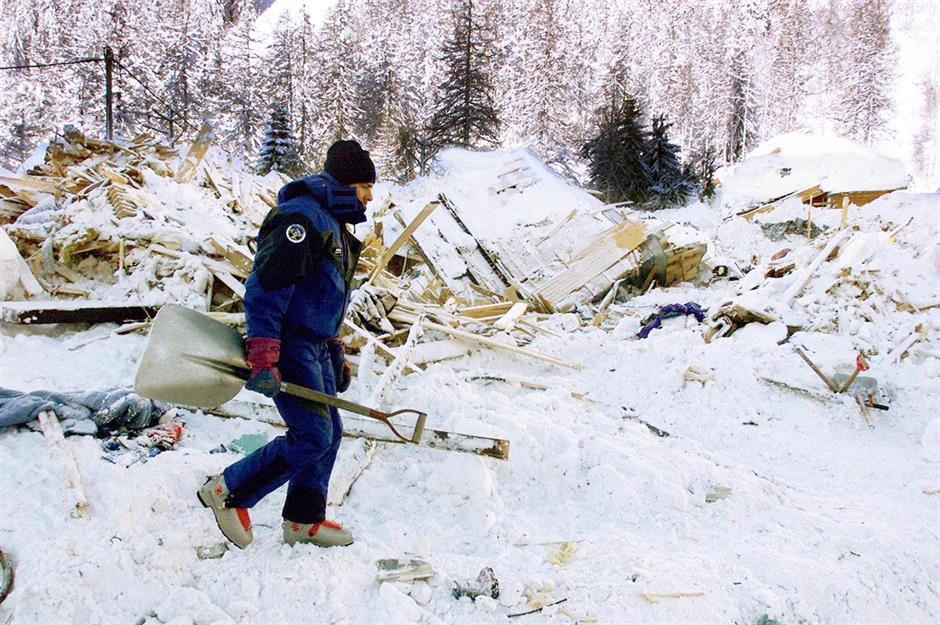
Montroc received heavier than usual snow that year, just as Andermatt had in 1951. In both cases, snow had fallen ceaselessly for days before the avalanche struck and, in Montroc, the avalanche risk was rated 'extreme'. Despite this, the chalets weren't evacuated.
As a result, 12 lives were lost and the Mayor of Chamonix, who was also the president of the Avalanche Safety Committee, was found guilty of manslaughter and received a three-month suspended prison sentence.
Vanishing mansions
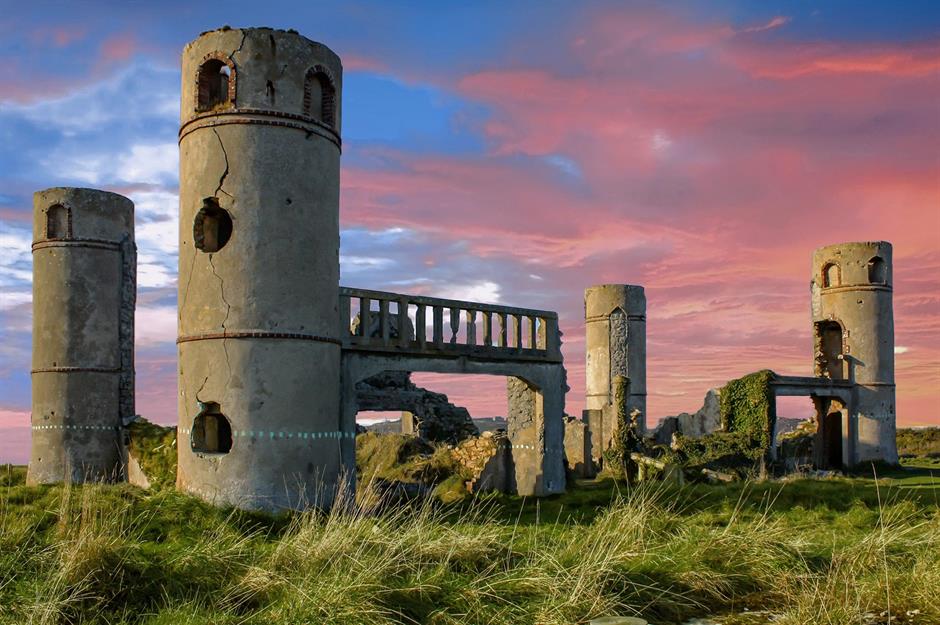
With times changing, fewer and fewer people can afford the upkeep of a large, extravagant home and many have been razed as a result.
Nowhere has this been more profoundly felt than the UK, where an estimated 1,200 country houses have been demolished in England alone since 1900. This is due to numerous factors, including war and the changing social landscape, which prioritises infrastructure such as new motorways.
Vanishing mansions: Watford, UK

Cassiobury House is stunning country house that fell victim to demolition. Located in Cassiobury Park in Watford, England, the Tudor building was built in 1546 for Sir Richard Morrison before undergoing remodelling in the 17th and 19th centuries.
Cassiobury House was slowly sold off for housing development purposes and was ultimately knocked down in 1927.
Vanishing mansions: Watford, UK
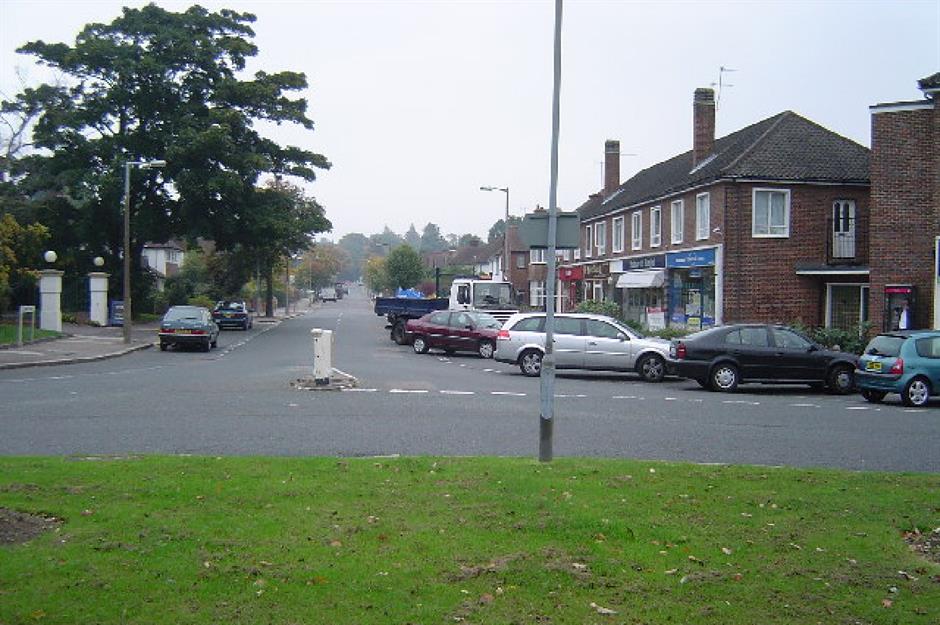
Pictured here in 2005, the Cassiobury grounds are now a housing estate, while the surrounding Cassiobury Park was turned into the main public open space in Watford.
As was the case with many country houses that were sold off, assets from the estate were bought up by museums and collections, including artworks and other valuable possessions.
Vanishing mansions: Staffordshire, UK
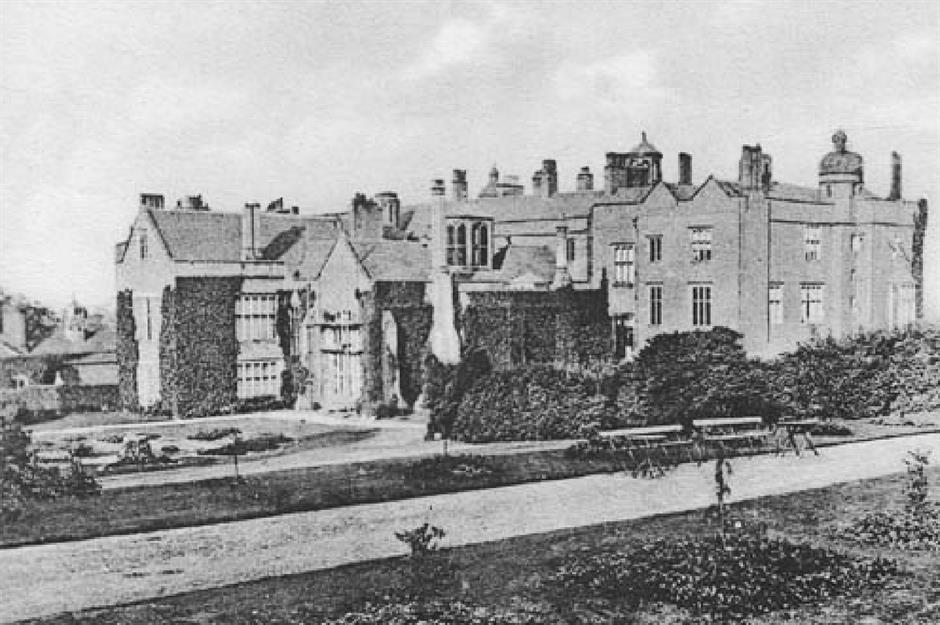
The seat of the Pagets, Earls of Uxbridge and Marquesses of Anglesey, from 1546 to 1935, Beaudesert Hall in Staffordshire was last occupied by Henry Paget, the 5th Marquess of Anglesey.
Known as the ‘Dancing Marquess’ for his snake-like dance routines, he wasn’t so adept with his finances and died bankrupt in 1904. His Beaudesert Estate was then sold off in 1932, having remained in the family for nearly 400 years.
Vanishing mansions: Staffordshire, UK
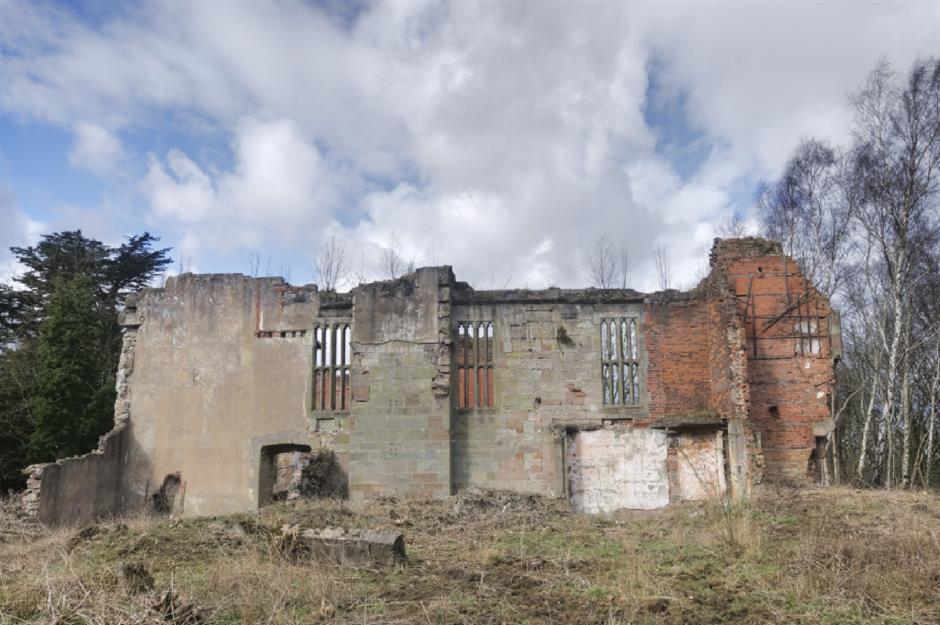
Today, Beaudesert exists in name and ruins alone. Perhaps financially cursed, even the contractors booked to demolish the struggling stately home went bust before they could complete the job.
The ruins were protected with Grade II-listed building status in 1953, after Lord Angelsey donated 124 acres (50ha) in 1937, to be used recreationally by scouts and guides and for other, similar purposes.
Demolished by the state

Whether it's due to desertion, illegal building or urban expansion, governments everywhere routinely demolish properties so the old can make way for the new.
However, for every building that's destroyed, someone loses a home, a business or a beloved landmark. Let's take a look at a couple...
Demolished by the state: Tenerife, Spain
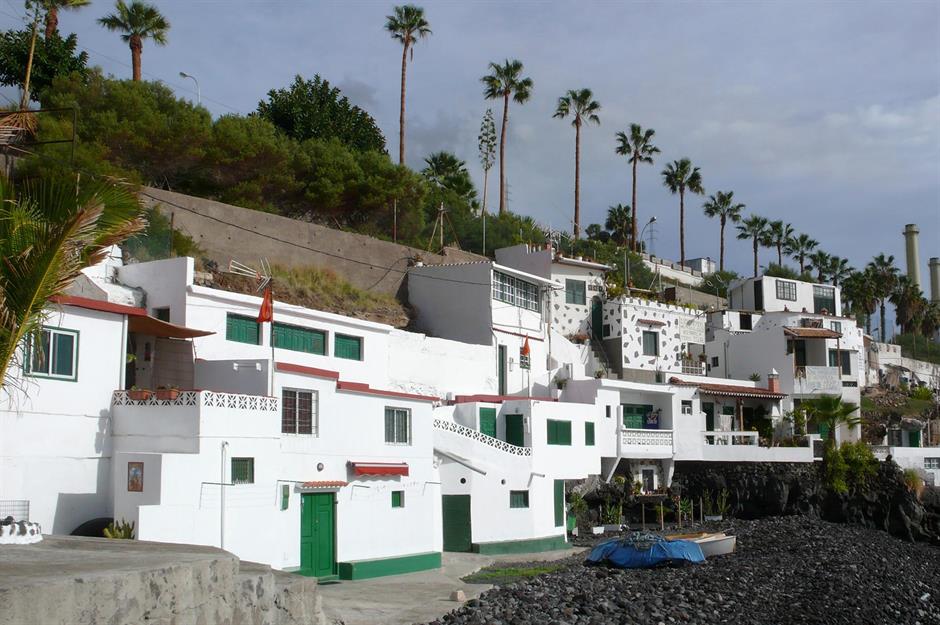
During the Spanish construction boom of 2001-2008, hundreds of thousands of illegal homes were built across the country. Bought in good faith by locals and expats a like, many of the homes built without the correct permits were the subject of decade-long legal battles, while others were simply demolished.
Meanwhile, properties like these charming homes in Cho Vito, Tenerife fell foul of other local laws and paid a sad price...
Demolished by the state: Tenerife, Spain
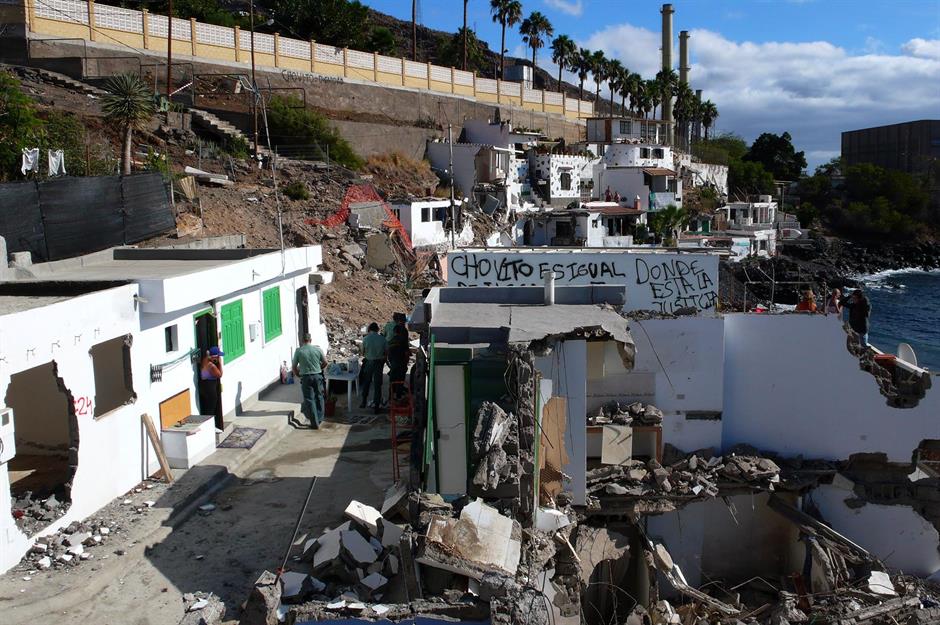
According to the Spanish government, the pretty white and green homes violated Spain's 1988 Coastal Law, which restricts private ownership along coastlines in order to combat coastal erosion and urbanisation.
Despite a long battle and vociferous protest from the homes' inhabitants, they were evicted – forcibly in some cases – and the 31 houses that made up the tiny fishing village were demolished.
Demolished by the state: Kunming, China

After sitting unfinished for seven years, 15 high-rise buildings in Kunming, China were destroyed in just 45 seconds. Captured here by New China TV, onlookers videoed the controlled demolition project as each building disappeared into rubble.
According to China’s state-run Xinhua News, explosives were used to demolish the abandoned skyscrapers, carefully placed at 85,000 blasting points within the buildings.
Demolished by the state: Kunming, China

Neighbouring buildings and shops were evacuated as part of a detailed, coordinated plan. But why were they demolished in the first place?
Authorities decided to destroy the buildings as they had been left abandoned, with their basements submerged in water. Taiwan News stated that the buildings, worth CN¥1 billion ($137m/£108m), were part of an unfinished housing project initiated in 2011.
Vanishing house
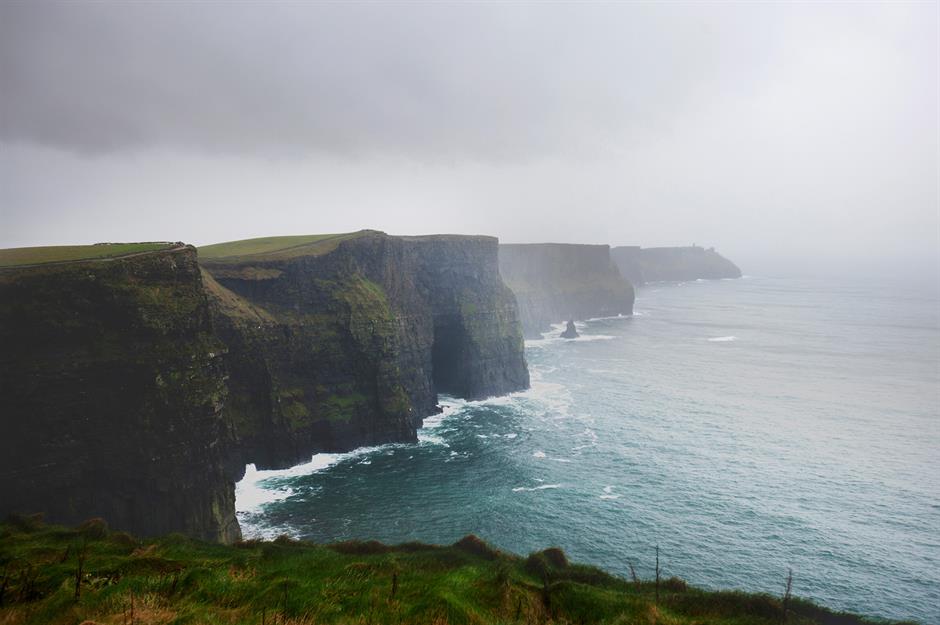
While the other ‘vanishing’ buildings can be explained away as a result of natural disaster or human intervention, this next case was – for a time – a genuine mystery. So much so that the tale of this disappearing residence in Ireland became the topic of a BBC 4 radio series, ‘The House That Vanished’.
A resident of Tory Island, Ireland, filmmaker Neville Presho’s house was there one day, gone the next...
Vanishing house: Tory Island, Ireland
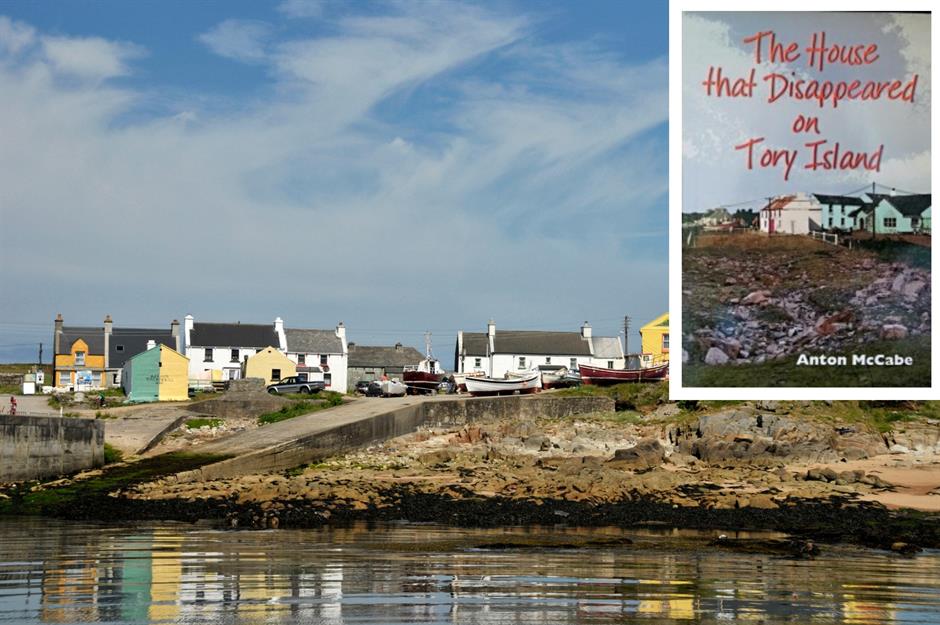
The remote and rugged Tory Island is home to around 120 residents. The isle captivated Neville Presho when he first visited the region in 1970 and he went on to purchase the 150-year-old house on the coastline in the early 80s, before moving to New Zealand.
Everything seemed fine until he returned to the island in 1994 and discovered that his house had vanished and that the site where it had once resided was now occupied by a septic tank and a hotel car park. The story was so bizarre, it was turned into a book by journalist Anton McCabe. The cover, shown here, shows the doomed house.
Vanishing house: Tory Island, Ireland
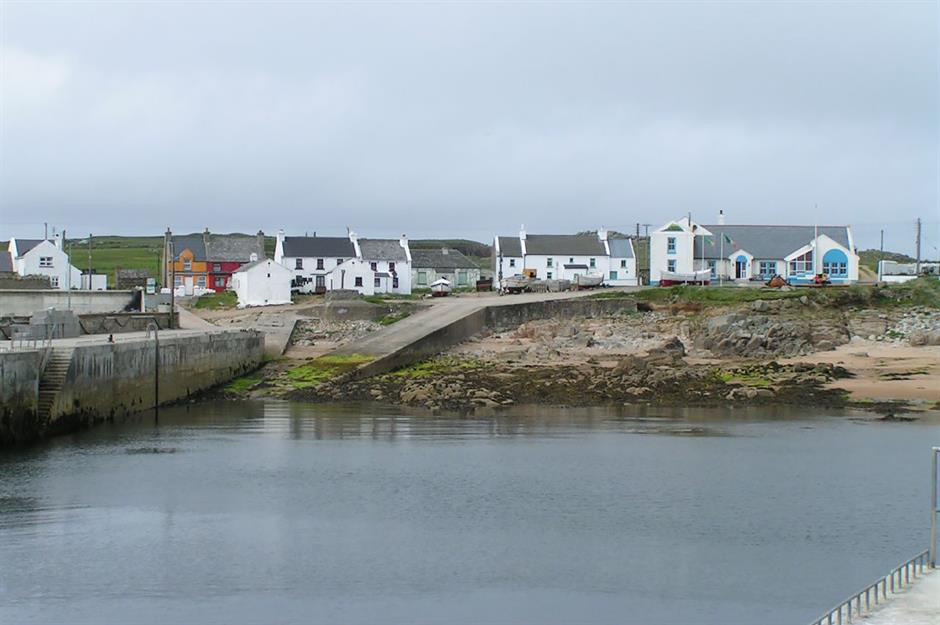
Presho swiftly took the hotel owner, Patrick Doohan, to court to find out exactly what had happened. The hotel and it's carpark can be seen here on the far right.
The judge ruled that Doohan should pay the damages and be liable for costs, and awarded Presho €46,000 ($48k/£38k), which he deemed insufficient, saying it "wouldn’t build a chicken coop", according to BBC News.
Vanishing house: Tory Island, Ireland
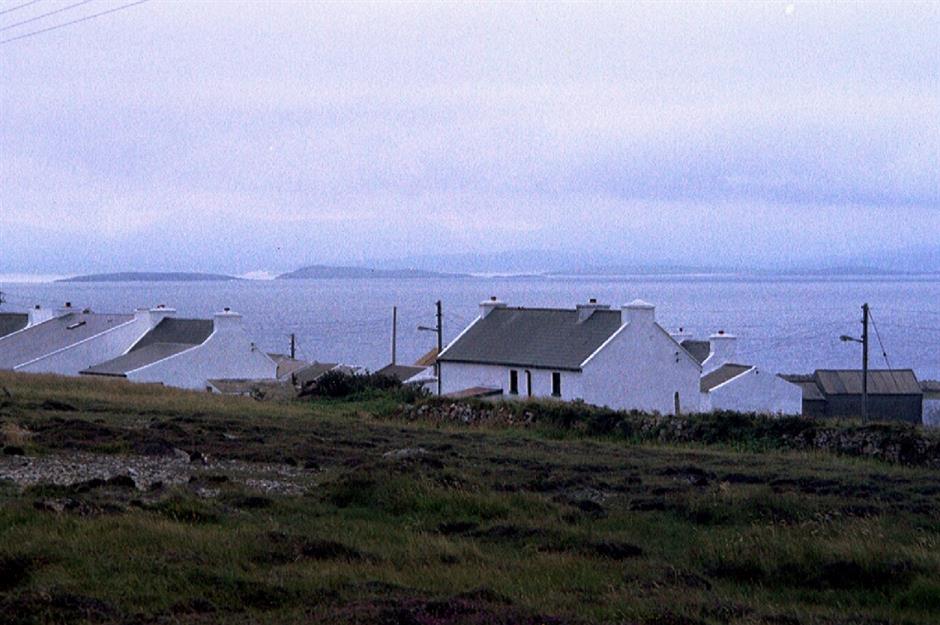
It was unusual for an ‘outsider’ to purchase property on Tory Island, but the filmmaker had been smitten. As such, he was understandably devastated by what happened. Presho suffered greatly as a result and was sectioned in mental health wards several times.
"It would be fair to say it destroyed his life and seriously impacted on his family's life," McCabe told the BBC.
Vanishing house: Tory Island, Ireland
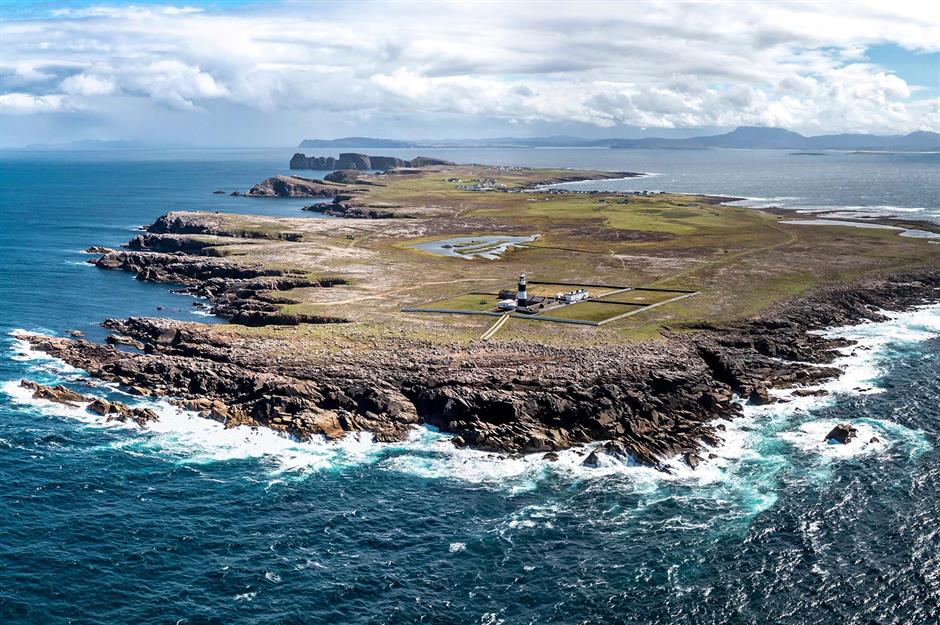
The high court discovered that the house had been bulldozed or damaged by fire in 1993 and subsequently removed over the following nine months, before Mr Presho returned in July 1994.
Unsurprisingly, the mysterious Wicker Man-esque story has captured the imagination of readers around the world.
Loved this? Discover more fascinating property stories
Comments
Be the first to comment
Do you want to comment on this article? You need to be signed in for this feature